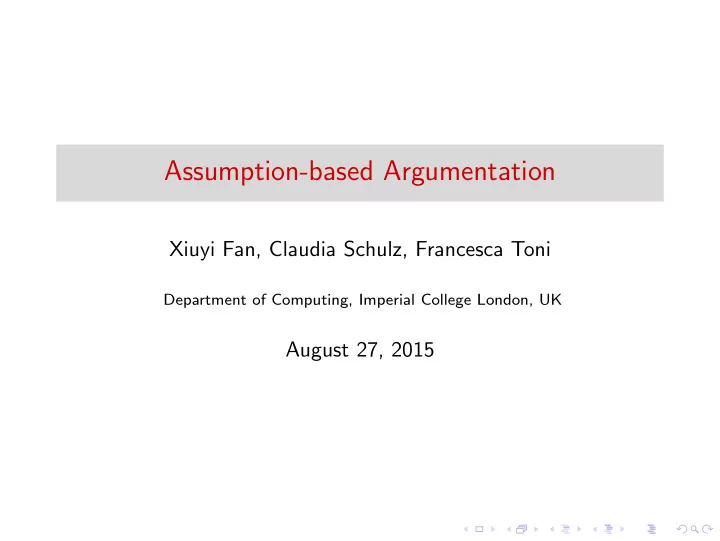

Assumption-based Argumentation Xiuyi Fan, Claudia Schulz, Francesca Toni Department of Computing, Imperial College London, UK August 27, 2015
Outline ◮ Assumption-based Argumentation (ABA) as a form of structured argumentation with roots in non-monotonic reasoning. ◮ Argument and attack are not primitive in ABA, but are instead defined in terms of rules in a deductive system, assumptions, and contraries. ◮ The added granularity allows to define a range of computational tools, from dispute trees to dispute derivations. ◮ These computational tools can also provide the foundation for multi-agent argumentative dialogues. ◮ ABA allows to support (some forms of) reasoning with preferences and defeasible rules without requiring any extensions. ◮ Its computational machinery allows to use ABA for computing explanations in various settings and senses.
Introduction Introduce ABA informally as a form of structured argumentation. Introduce the spirit of the chapter. Mention computational complexity of ABA. Mention connections between chapter and other recent surveys/tutorials in ABA.
ABA Syntax and Semantics Introduce the syntax of ABA and its standard semantics (admissibility, grounded, etc) in terms of assumptions and extensions. Discuss the relation of ABA with with Abstract Argumentation.
ABA and Non-Monotonic Reasoning Show instances of ABA for Non-Monotonic Reasoning. In particular, give the Logic Programming instance and the Default Logic instance (both are non-flat). Discuss non-flat ABA and other forms of non-monotonic reasoning (e.g. non-monotonic modal logic)
ABA and Defeasible Reasoning Show how defeasible reasoning can be performed in ABA, including how to encode preferences of different kinds (notably following the last-link principle and preferred subtheories).
Dispute Trees and Dispute Derivations Introduce dispute trees as a device for computing ABA semantics and show how to get from dispute trees to dispute derivations. (AIJ papers 2006, 2007, 2013)
ABA Dialogues Introduce dialogues as a distributed counterpart of computing ABA semantics. Consider various kinds of dialogues (e.g. information-seeking, inquiry, persuasion) and present how they are naturally supported in ABA. (AIJ paper 2014)
ABA and Explanation Show the explaining power of ABA in Logic Programming and decision making, and how this power relies on the computational machinery of dispute trees. (TPLP paper 2014, AAAI paper 2015)
Recommend
More recommend